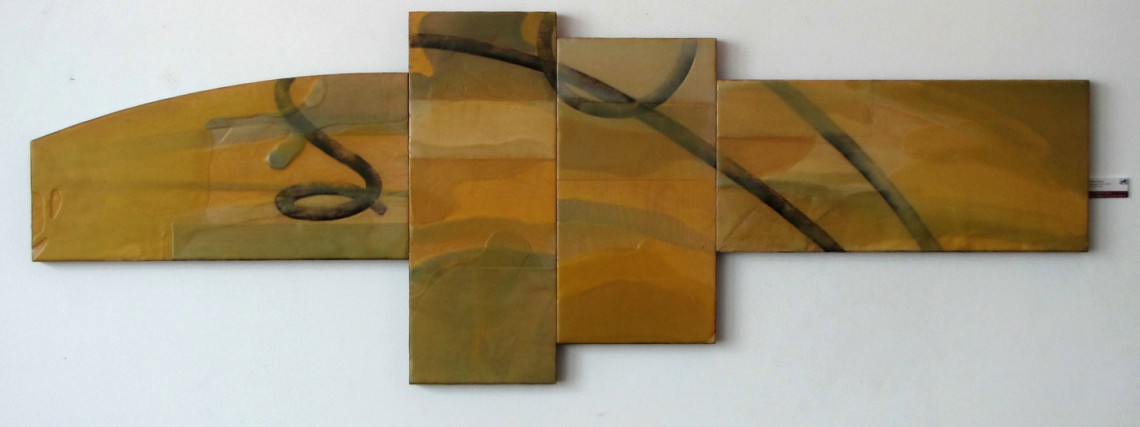
Photo by DeWitt Cheng.
Howard Hersh, Aggregation 04-07, 2004Wax works by local artists
Stanford Art Spaces displays encaustic works by Mari Marks and Howard Hersh.
Stanford Art Spaces announces its January-February 2015 art exhibitions: The Spiritual Landscape by Mari Marks and One Day at a Time: Thirty Years in the Studio by Howard Hersh. Both are accomplished Bay Area artists: Marks lives in Berkeley, and Hersh in San Francisco.
Both employ the medium of encaustic, i.e., powdered pigments bound in beeswax (instead of the linseed oil used in oil painting). Encaustic has been used since ancient times, most famously in the later-dynasty portraits on Egyptian coffins.
Marks and Hersh employ the medium not to commemorate the dead but to create abstractions that combine suggestions of natural imagery—terrain in Marks’ work, botany in Hersh’s—with hints of calligraphy; they combine and contrast the complexity of the reality with the pictograms and phonograms (to return to ancient Egypt) of the written/sounded universe of language.
Marks’ layered, scraped paintings, with their hallucinatory patterns, resemble minerals; her incised-wax and graphite tableaux suggest vast landscapes morphing into scrolls, and vice versa. In 2005, San Francisco art critic Terri Cohn wrote: “Mari Marks’ encaustic and mixed media works consistently evoke a sense of suspended time. Marks employs the plastic qualities and translucent properties of wax as a medium in which to form textures and suspend materials and pigments in ways that elicit memory.”
Marks writes of her work: “Through over 15 years of working with beeswax I have explored pattern in layering beeswax, pigment, and natural materials. … In reducing my work to the elements of color, heat, and sedimentary deposit, I value the materiality, the process, and the natural laws underlying the formation of the natural world.
“In The Spectrum Studies, the imagery is reduced to the basic element of encaustic painting, color and layering. Multiple layers of pigment and interference pigments are evenly scraped to reveal subtle patterns created in the process of the even layering of the pigmented beeswax.
“In The Sedimentary Series, pattern is created through fine sedimentary materials (graphite, ashes, earth) in layers on the wax, which in heating become part of the wax structure. In the larger pieces, the sediments may be incorporated into the wax or deposited through etched or carved mark making. Heat and light ‘burn in’ the sediment deposits. In all these images, I explore natural processes implicit in creation of earth and geological features.”
Hersh summarized his ongoing concerns in his art in an interview several years ago: “My work has a very philosophical underpinning. Most of my artist statements go into relationships between things. Real/imagined, natural/manmade, etc. My premise is that there is no separation and that everything is nature itself. I try to communicate this in my work by combining disparate elements and then allowing them to integrate. … I’ve always worked in a serial fashion. I’ll pursue a theme until it gradually morphs into something else.”
In his recent series Skin Deep, wall reliefs combining cutout plywood geometric shapes and wooden scaffoldings interweave in a complex 2D-3D ambiguity, the latest stage of his philosophic/artistic evolution. “The formal concerns have always been about relationships,” said Hersh. “Although series shifted [emphasis] over the years, my philosophy of ‘no separation’ has always been present. Early on, it was the relationship of the figure in the landscape. Over time, … light and energy replaced [the figure]. I then became interested in the man-made versus the natural world.
“This evolved into a series, Nature of Architecture, … where I used plant tendrils against geometric shapes. Waves and Particles was the next major series that I undertook. Man-made versus natural prevailed, but changed imagery. It became mechanically assisted marks against paint pours controlled by natural forces; gravity and surface tension. My most recent work examines the interaction of two- and three-dimensional artwork.”
The exhibitions continue through March 6, 2015. There will be a reception for the artists on Thursday, Jan. 29, from 4:30 to 7 p.m. in the David Packard Electrical Engineering Building, west of the Main Quad. See Facebook.com/StanfordArtSpaces for directions and updates. Parking at all university lots and structures is free after 4 p.m.
Stanford Art Spaces is a local art exhibition program serving the Paul G. Allen Building, housing the Center for Integrated Systems, the program’s longtime sponsor, and the David W. Packard Electrical Engineering Building, with smaller venues located throughout campus. All are open during normal weekday business hours. For further information or to arrange a tour, contact Curator DeWitt Cheng at (650) 725-3622 or dewittc@stanford.edu.
